MPLS DiffServ
MPLS DiffServ Traffic Classification
In DiffServ model, traffic classification is implemented at network edges to classify packets into multiple priorities or service classes. If the IP precedence fields in IP headers are used to identify packets, the packets can be classified into eight (23) classes. If the DSCP fields in IP headers are used to identify packets, the packets can be classified into 64 (26) classes. On each node through which packets pass, the DSCP or IP precedence fields in IP headers are checked to determine the per-hop behavior (PHB) of the packets.
On an MPLS network, however, the label switching router (LSR) does not check the IP header information. Therefore, traffic classification cannot be implemented based on the ToS or DSCP fields of packets. Relevant standards define two schemes for traffic classification on an MPLS network.
Scheme 1: E-LSP
The EXP-Inferred-PSC LSP (E-LSP) scheme uses the 3-bit EXP value in an MPLS header to determine the PHB of the packets. Figure 1 shows an MPLS header.
The EXP value can be copied from the DSCP or IP precedence in an IP packet or be set by MPLS network carriers.
The label determines the forwarding path, and the EXP determines the PHB.
The E-LSP is applicable to networks that support not more than eight PHBs. The precedence field in an IP header also has three bits, same as the EXP field length. Therefore, one precedence value in an IP header exactly corresponds to one precedence value in an MPLS header. However, the DSCP field in an IP header has six bits, different from the EXP length. Therefore, more DSCP values correspond to only one EXP value. As the IEEE standard defines, the three left-most bits in the DSCP field (the CSCP value) correspond to the EXP value, regardless of what the three right-most bits are.
During traffic classification, the EXP value in an MPLS packet is mapped to the scheduling precedence and drop precedence. Except traffic classification, QoS operations on an MPLS network, such as traffic shaping, traffic policing, and congestion avoidance, are implemented in the same manner as those on an IP network.
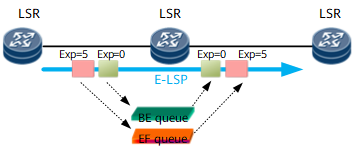
When the MPLS packet is leaving the LSR, the scheduling precedence and drop precedence are mapped back to the EXP value for further EXP-based operations on the network.

For more details about the default mapping between the EXP value, service class, and color on NetEngine 8000 Fs, see QoS Priority Mapping.
Scheme 2: L-LSP
The Label-Only-Inferred-PSC LSP (L-LSP) scheme uses labels to transmit PHB information. The EXP field has only three bits, and therefore cannot be used alone to identify more than eight PHBs. Instead, only the 20-bit label in an MPLS header can be used to identify more than eight PHBs. The L-LSP is applicable to networks that support more than eight PHBs.
During packet forwarding, the label determines the forwarding path and scheduling behaviors of the packets; the EXP carries the drop precedence. Therefore, the label and EXP both determine the PHB. PHB information needs to be transmitted during LSP establishment. The L-LSPs can transmit single-PHB flow, and also multi-PHB flow that has packets of the same scheduling behavior but different drop precedences.
Comparison Between the Two Schemes
In the L-LSP scheme, an LSP must be established for each type of services from the ingress LSR to the egress LSRs. An L-LSP supports only one type of service.
In the E-LSP scheme, only one LSP needs to be established between the ingress and egress LSRs to support up to eight PHBs.
E-LSP |
L-LSP |
|---|---|
The EXP determines the PHB (including the drop precedence). |
The label and EXP determine the PHB. |
No additional signals are needed. |
Signals are needed to establish LSPs. |
Each LSP supports up to eight behavior aggregates (BAs). |
Each LSP supports only one BA. |
The principles for selecting L-LSPs or E-LSPs are as follows:
- Link layer: E-LSPs, L-LSPs, or both can be used.
- Service type: Up to eight PHBs are supported if only E-LSPs are used. To support more than eight PHBs, you must use L-LSPs or use both E-LSPs and L-LSPs.
- Network load: Using E-LSPs reduces the LSP quantity, label resource consumption, and signaling. Using L-LSPs is more resource-consuming.
Generally a network provides a maximum of four types of services, which can be transmitted using E-LSPs. L-LSPs are used on networks that require the QoS guarantee for various services with different drop precedences. NetEngine 8000 Fs support E-LSPs only.
CoS Processing in MPLS DiffServ
The DiffServ model allows transit nodes in a DS domain to check and modify the IP precedence, DSCP, or EXP value, which is called the class of service (CoS). Therefore, the CoS value may vary during packet transmission.
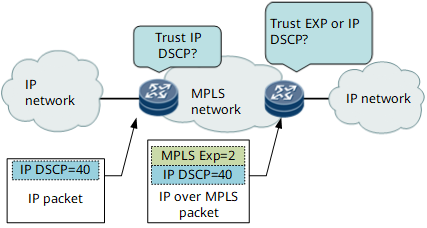
Carriers need to determine whether to trust the CoS information in an IP or MPLS packet that is entering an MPLS network or is leaving an MPLS network for an IP network. Relevant standards define three modes for processing the CoS: Uniform, Pipe, and Short Pipe.
Uniform Mode
When carriers determine to trust the CoS value (IP precedence or DSCP) in a packet from an IP network, the Uniform mode can be used. The MPLS ingress LSR copies the CoS value in the packet to the EXP field in the MPLS outer header to ensure the same QoS on the MPLS network. When the packet is leaving the MPLS network, the egress LSR copies the EXP value back to the IP precedence or DSCP in the IP packet.
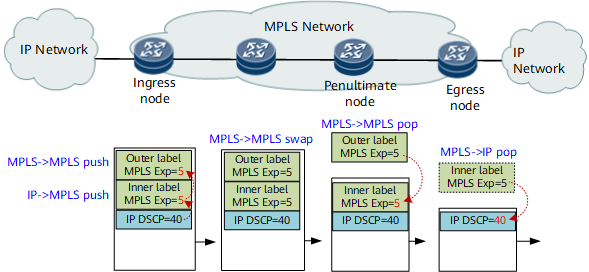
As its name implies, Uniform mode ensures the same priority of packets on the IP and MPLS networks. Priority mapping is performed for packets when they are entering or leaving an MPLS network. Uniform mode has disadvantages. If the EXP value in a packet changes on an MPLS network, the PHB for the packet that is leaving the MPLS network changes accordingly. In this case, the original CoS of the packet does not take effect.
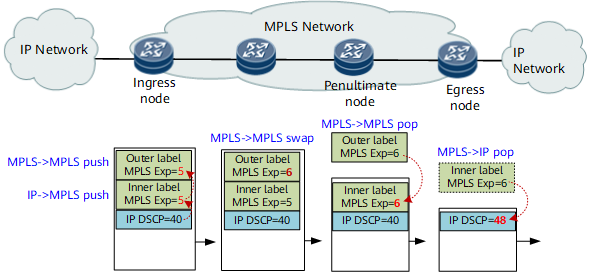
Pipe Mode
When carriers determine not to trust the CoS value in a packet from an IP network, the Pipe mode can be used. The MPLS ingress delivers a new EXP value to the MPLS outer header, and the QoS guarantee is provided based on the newly-set EXP value from the MPLS ingress to the egress. The CoS value is used only after the packet leaves the MPLS network.
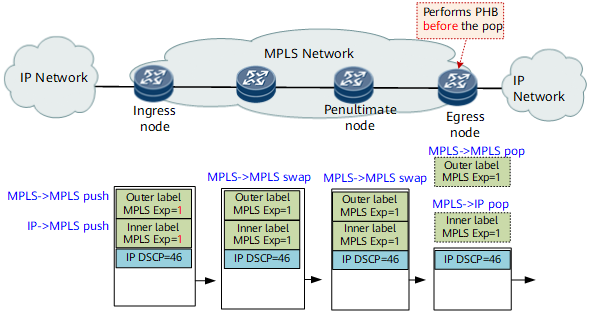
In Pipe mode, the MPLS ingress does not copy the IP precedence or DSCP to the EXP field for a packet that enters an MPLS network. Similarly, the egress does not copy the EXP value to the IP precedence or DSCP for a packet that leaves an MPLS network. If the EXP value in a packet changes on an MPLS network, the change takes effect only on the MPLS network. When a packet leaves an MPLS network, the original CoS continues to take effect.

In Pipe mode, the egress implements QoS scheduling for packets based on the CoS value defined by carriers. The CoS value defined by carriers is relayed to the egress using the outer MPLS header.
